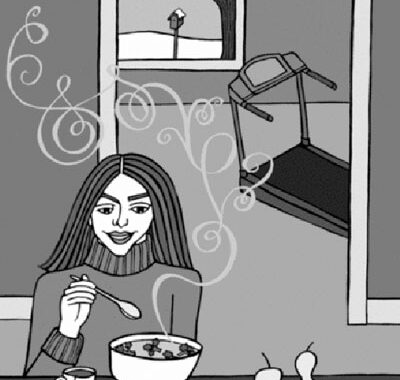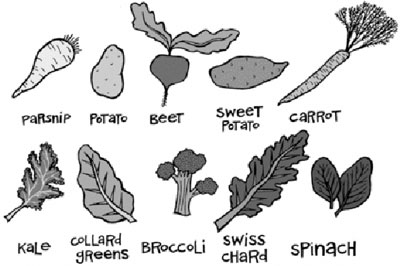
Feeding Your Inner Hibernator
by Ilyse Simon
Illustrations by Annie Internicola
It’s October. The fresh peaches of summer are sweet history, the farmers’ markets are closed, and autumn is here to remind us that this is a season of change. There are modifications to our wardrobe, adjustments to the darkness that greets us in the waking hours, and variations in our daily routines. The cooler temperatures push us indoors, hungry for books and crafts and other notably sedentary activities, preferably in front of a warm fire.
We also need a bit of added insulation with the drop in the thermometer. For many of us, the extra layers may not be sweaters and scarves but unwanted pounds acquired from creamy noodle kugels, pot roasts, comfort desserts, and other calorie-rich foods. Gone are the salads plucked from the backyard vegetable garden and emerald stalks of broccoli for a couple dollars.
With the seasonal decline of affordable and appealing produce, it’s natural that the contents of our shopping bags and menus have shifted. We load up on grains and proteins, not fresh salads and tree-ripened fruit, and then cover them with butter, cheese, or gravy.
Seasonal Eating
There’s a reason we are drawn to different foods with the passing of seasons. Holly Anne Shelowitz, a certified nutrition counselor at Nourishing Wisdom in Stone Ridge, explains: “It’s part of our evolution for our diet to change when the season changes. In winter, cravings kick up for heavier foods like sweets and comfort foods. Appetites increase and our bodies want to be warm and satisfied. Our bodies strive for balance, so it’s unlikely we will crave watermelon and things that have natural rhythms in warm weather. It’s why a steaming bowl of oatmeal sounds so appealing in the colder weather.”
Ellie Wilson, senior nutritionist at Price Chopper in Schenectady, notes, “We wouldn’t make a turkey dinner in July, but we don’t think twice about it in December.” Wilson is quick with a tip on how to lighten the load when the season turns cold and dark. “I continue to cook familiar dishes, albeit heavier foods, yet make them higher in fiber. Stop peeling your potatoes before you put them in the stew. Consider using other vegetables like parsnips and sweet potatoes. The variety offers people different flavors, more fiber, and a nutrient bang for their buck.”
Soups and stews are winter’s answer to lots of things. They are warming, satisfying, and can be the ultimate vehicle for vegetables. If you are not a raving fan of vegetables, pile them into your favorite bean soup, add a spin from the hand blender, and voila! You’ll never know what’s hidden in that bowl. Open a package of frozen broccoli and dump it into your crockpot creation. No washing, no chopping, no fuss.
Wilson acknowledges, “For some, the inclination to cook during the winter declines. Sticking chapped hands under cold water to wash a bunch of kale is not enticing. And for people who feel like they have less time to plan and prepare meals, I tell them to use frozen veggies to augment already prepared foods. There are some brands of prepared soups that are low in sodium, like Imagine or Amy’s, which are a great place to start. Add some frozen spinach to the soup and a slice of whole-grain bread, and you have a light meal, but still warm winter food.”
Filling in for Light, Air, and Movement
Still hankering for starchy, cheesy, or sweet stuff? Is it the call of our wild side to store fat over the winter and hunker down in a cavelike condo? Or are our stomachs weak to temptations of buttery, crusty scents? It’s probably both. Unconsciously we may feel the evolutionary pull to stock up on calories for winter, and therefore give our desire for tasty comfort foods a little more leeway.
Our cravings for mashed potatoes, steak, and cinnamon rolls may contain a nugget of insight. Shelowitz swears that there is a form of body intelligence in those cravings. She says, “Carbohydrates and fat provide warmth in the body. So there is wisdom in those cravings. But it’s not about eating white bread, French fries, and doughnuts.” She attributes these food desires to the reduced exposure to the outdoors.
Winter, says Shelowitz, “is a time of year when people are not so physically active. We are indoors more and not getting as much sunlight and fresh air. Sun and fresh air are energizing to the body. When we are not receiving that natural form of energy, the body craves other ways of getting it [enter glazed doughnut and mocha]. Of course, carbohydrates provide the exact opposite type of energy. You might get an initial buzz, like with sugar, but eventually there is low energy or a letdown. Ultimately, it won’t be very satisfying—and that’s why people continue to crave them.”
Meeting our needs for sunshine and movement can be trickier when the air is sharp. If you have established healthy activity habits, don’t abandon them due to the weather. Adapt your routine. Wilson says, “Whether due to cold weather or concern about injury, so many of us stop walking from November to April. A great way to stay connected to your fitness goals is with a DVD or exercise routine in the home. Walking DVDs are geared from one- to three-mile increments, and there’s no need to be concerned about traffic. It is an inexpensive way to stay active.”
The Loneliness Factor
So the question becomes: How do we get the energy we need when “energy” is not just a matter of calories? Energy also means our vital force. That can be harder for some of us to connect with in the winter. It’s a season of solitude. Shelowitz says, “Winter can be lonely. That’s a big piece. We are lonely and want comforting foods. In addition, people can lean toward depression in the winter, and eating more can be a way to try to get out of it.”
Succumbing to those starchy cravings doesn’t help loneliness or depression in the long run. Shelowitz has a better idea: Cook with friends. Prepare meals as a group activity. It’s fun and nurturing in ways other than just providing nutrients. It quenches the isolation many of us succumb to on frigid days and long, dark nights.
Caving to cravings the healthy way
If you can’t subdue the need for a feel-good food, acknowledge that the craving is telling you something. It’s your body’s way of shouting “I have a need!” But you can work with your cravings. What if you have a hankering for warm French bread with butter to satisfy a carb craving, for instance? Shelowitz encourages her clients to meet their desire for bread with more whole grains in their diets. She says, “Pair whole grains like quinoa and kasha with healthy fats such as butter or coconut oil, so that you can meet your body’s needs for those foods in healthy ways.”
And what if you have gotten your daily dose of sunshine, joyful movement, and friends, and still want something sweet and starchy? Healthy desserts are not an oxymoron. You can make desserts that are actually nourishing to your body and soul. Start with some seasonal sweet source. Apples and pears are great staple fruits for the winter. Shelowitz suggests, “Bake apples, pears, and yams in a casserole dish with butter and cinnamon, and sweetened with maple syrup. It’s local, delicious, and the house smells beautiful. The nourishing, warming, comforting needs are being met (with the aromas) before we’ve even taken a bite of the food.” Warm compotes of dried plums, figs, apricots, and spicy cinnamon-ginger applesauce can nurse your sweet craving ’til summer, too. So, go ahead, eat a healthy dessert. No, not every day, but when you really want it.
The Color of Chlorophyll
Are the colorful falling leaves pressed between the pages of your cookbooks the only multihued things that make it to your kitchen? Green is not just the color of money. It’s the color of chlorophyll—the lifeblood of all flora. Dark leafy greens like kale, collards, broccoli, swiss chard, and spinach are perfect when steamed, sauteed in omelets, and tossed in soups. Shelowitz says, “In the wintertime, we are missing the color green from the landscape. Green brings sunshine into your body, it’s cleansing; and greens are rich in chlorophyll and high in minerals.” Wilson agrees. “You want to make sure it’s not a white-and-brown diet during the winter. Add a big side of steamed green beans to your meal.”
For the artist in us all, it is fun to use color to help us achieve nutritional balance. Ensure that a rainbow of color is represented each time you sit in front of a plate of food. Browns, tans, and whites only count if they mean mushrooms and cauliflower. If your staple dinner is macaroni and cheese (artificial coloring does not count either), you might start by adding one color to each meal. Broccoli mac and cheese is ever so yummy. By adding a good helping of this colorful, vitamin- and fiber-rich vegetable, you will need less of other foods to fill you up. Other great color foods are steamed carrots, purple cabbage, and beets.
Playing with Portions
Wilson stresses that it’s important to keep familiar foods on your menu, while adding higher fiber vegetables. She suggests, “Double the size of less calorie-dense foods (vegetables) and reduce your portion of higher-calorie foods (i.e., everything else). For example, take three servings of spinach—fill half of your plate—a small baked potato, and a third less of your usual steak serving. The plate is still full, but there’s 250 fewer calories on it. By changing portions and adding foods, you can manage the quantities of ingredients that are calorie-dense.”
Quick-fire Challenge
Here’s a test. It’s lunchtime. You reach for a grilled cheese sandwich and chicken noodle soup. Then, like a bolt of lightning, it hits you, and you see the colors about to settle on your plate: white and tan (and maybe pale orange). Quickly, you shove the chicken soup back in the cabinet and tug at the can of hearty vegetable way in the back. Then you make a mad dash for the freezer, pull out a handful of frozen spinach, and plop it in your soup cooking on the stove. “Wait! Wait! The sandwich!” you exclaim. You know you can brighten up the pasty-white duo. You slice some gorgeous purple onion and nestle it between the Colby. You are on a roll. You throw open the fridge and frantically sort through bottles and jars…ah! There, behind the mustard and capers, is the jar of roasted red peppers from that time you made pizza. You open the lid, take a sniff, and decide it’s still good. Voila! You have created a masterpiece. From blah to ahhh in two minutes flat. You sit down to regard your creation. It’s lovely, satisfying, and delicious. You vow to do it again!
Find your Balance
Balance comes in many shapes and sizes. It can be a balance of exercise versus movie watching, pasta versus broiled chicken and greens, snack versus meal, and, of course, nutritious food versus Green and Black Organic chocolate. It’s not everyone who can be a high wire artist, for whom balance is innate. For the rest of us, it takes a bit of mindfulness to get the nourishment we need, the treats we want, and the wisdom to know the difference. Planning will get you through the day in food-choice balance. Plan for meals to be a colorful balance of vegetables, whole grains, fruits, proteins, and healthy fats. Balance a bagel-with-cream-cheese breakfast with baked tilapia, lentil soup, and cabbage for dinner. Strategize your weekly food choices, too. If you know you have a party on Saturday, and you’ll want to try half of the desserts, plan to limit your sweet indulgences the week before.
Wilson’s personal game plan for balance at parties and special occasions is to eat what is special for the season. She says, “I look at the holiday buffet and think about which foods I will only get at this time of year. So I have the eggnog and sweet potato casserole, and I don’t eat the typical chips and dips. If it’s my mother’s almond crescent cookies I’ll eat it, but not a plain cookie that I could get at any time of the year.”
So pull out a cookbook, invite over some pals, and get creative with the greens of Lacinato kale and the oranges of kubocha squash. Don’t let seasonal habits take a toll on your health. Get outside in the sunshine for a few minutes each day. Fill up with nourishing food and nourishing activities. Let the seasonal changes guide your eating toward appropriate choices. And remember: There’s wisdom in those cravings.
Join here to receive my free guide with 5 easy ways to boost your immune system PLUS one of my favorite recipes!
By signing up for this free guide, you’ll also receive recipes and nutrition tips in your inbox

